50 Years of Missionary Language Training: Readers Share How They Learned Their Mission Language
Contributed By Christine Rappleye, Deseret News
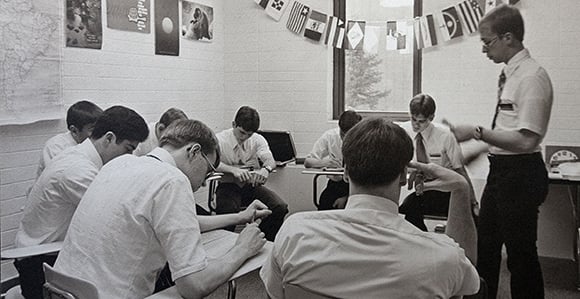
The caption information found on the frame plaque accompanying this historical photo reads: “Missionaries spend many classroom hours each day learning foreign language and missionary discussions, practicing teaching skills, studying scriptures, and developing deeper understanding of gospel doctrines and principles.” The photo is one of nearly a dozen historical photos showing the development of the Language Training Mission and Missionary Training Center facilities in Provo since the 1960s.
Article Highlights
- Language training programs for missionaries began 50 years ago in 1969.
- Readers shared how they learned their mission language.
Related Links
Language training for missionaries of The Church of Jesus Christ of Latter-day Saints has ranged from when early missionaries spent time learning in-country to the more structured training provided by the Language Training Mission and the current missionary training centers worldwide.
An entry in the 2013 Church Almanac notes that in January 1969—50 years ago—“Two-month language missions began. Language training for missionaries prior to their departure to their mission field first began in the early 1960s for Spanish, Portuguese, and German language missions.”
The Language Training Mission was established in the 1960s in the Hotel Roberts and other Brigham Young University buildings, including the Amanda Knight Hall and the Knight Magum Building. The missionary training center in Provo opened in the 1970s, and there are several other missionary training centers around the world.
The Deseret News asked readers for their experiences learning a language while serving a mission, whether they learned in-country or in a more formal training setting. There was an overwhelming number of responses. Here are several of the experiences, which have been edited for length and clarity.
***
I studied French a year in junior high, two years in high school, and one year in junior college. I served a mission in the Franco-Belgium Mission from November 1965 to May 1968. Learning by mastering the six discussions in French and being immersed in the Waloon and French cultures, with the foundation of my language education, is how I became proficient in French. After retirement, I finished my lengthy French academics and received a bachelor’s degree in French in 2014.
—Michael D. Russell, Spanish Fork and St. George, served in the Franco-Belgium Mission, November 1965 to May 1968, French speaking
***
My experience was a positive one for me. I am now 73 years old and I still speak Portuguese, the language I learned as a 20-year-old.
—Alfred Verboonen Fabela, Pittsburg, California, served in the Brazilian Mission, 1965–1967, Portuguese speaking
***

“Bidding for construction of the Language Training Mission opened July 2, 1974. By November 1, the foundations of several buildings were above ground.” —This is the caption information found on the frame plaque accompanying this photo, one of nearly a dozen historical photos showing the development of the Language Training Mission and Missionary Training Center facilities in Provo since the 1960s. Photo provided by the Provo Missionary Training Center.
We started our two-year mission in 1972 in an old school by Temple Square and ate downstairs at the Hotel Utah. After a week there we went to the Provo LTM to start learning French, which was also taught there. We used some word plays with English words that when put together sounded like French phrases.
—Roger T McDowell of Snowflake, Arizona, served in the Belgium Brussels Mission, October 1972–October 1974, French and Wallon speaking
***
The Language Training Mission began with the initial filing process to serve a mission. We were required to take a test at the Institute of Religion on the campus of University of Southern California in Los Angeles. I went with two other friends and we were to listen to a record (that was the technology of the day) and follow directions. It was later on that the language we were tested with was the Kurdish language. My buddies ended up going to the Rockford Illinois Mission and England. I recall joking with them, “I guess we know who passed the test!” I was also at the LTM over Thanksgiving and Christmas of 1973, which included the funeral of President Harold B. Lee.
—Raymond Kent Race of Mesquite, Nevada, served in the Central American Mission (Honduras, Nicaragua, Costa Rica, and Panama), November 1973–November 1975, Spanish speaking
***
Scandinavian languages, Finnish and Dutch, were taught at then Ricks College in Rexburg, Idaho, in the late 1960s. The missionaries stayed in a large pink house just off campus. Most missionaries were up on time due to the hot water always running out while taking showers. Meals and classes were on campus. During the time I was there we were able to get exercise playing soccer and basketball. … We worked hard, and it was exhausting. One was particularly tough. She made us repeat phrases in unison until we said them correctly. Everyone was happy to move on to his or her fields of labor. Finnish was a difficult language to learn. Every time I heard an elder going to Finland pray, I was glad I was going to Sweden.
—Robert Wayne Jacobson of Farmington served in the Sweden Mission, March 1972–March 1974, Swedish speaking
***
My language training began with taking a standardized exam that was given to all prospective missionaries as part of the application process to determine foreign language aptitude. This was part of the missionary application process. When I entered the LTM, my first few days of classroom learning were confused with the French language I had studied in school. I had to make a concerted effort to “forget” in order to learn Spanish. We were encouraged to speak Spanish at all times with our companions and during our lessons. …
It probably took about two months before I felt more comfortable and fluent in both speaking and understanding. During that time when we were in Church meetings or speaking with investigators, I went through a little mind game of “listen, translate; translate, speak; repeat.” Eventually I was thinking and praying in Spanish, and if there were words that I didn’t understand, I could still get the context of what was being discussed. One of the greatest blessings came several months into my mission when I was assigned to a companion whose native language was Spanish.
Upon leaving the mission field, my companions and I separated at the airport in New York City. At times I was talking to the people next to me on the plane, not realizing I was speaking to them in Spanish. Shortly after I returned home I secured a position as a teacher’s aide in a nearby school district. Out of about 50 applicants, mostly native Spanish-speakers, I placed third in the language skills the administrators were looking for. Today when I hear certain words or sing certain Church hymns, I fondly recall that I first learned them in Spanish.
—Rochelle R. Hale of Simi Valley, California, served in the Argentina East (renamed Argentina Rosario) Mission 1974–1976, Spanish speaking
***
It was hard and exciting at the same time. Learning the German language in eight weeks was difficult—especially as a new convert and trying to learn about the Church’s culture at the same time. I have fond memories of making friendships and testimony building experiences. I was in Amanda Knight Hall and love to go by it every time I’m in Provo.
—Richard Berlie Wright of Orangevale, California, served in the Switzerland Zurich Mission, 1975–1977, German speaking
***
I’ll always be grateful for the time I spent at the Language Training Mission. It gave me a solid foundation of language training and the scriptures and how to hear the language of the Spirit. The language training was intense and fast. I remember we covered in the first week at the LTM what it took an entire semester to cover in my first Spanish class in college. I really felt I was being taught by the Spirit because I struggled a bit with Spanish in college before my mission, but at the LTM it just came together. We also were supposed to memorize dozens of scriptures that went along with the discussions that we were learning. I know I was blessed with the ability to memorize and remember scriptures like never before also. Learning the discussions was more of a challenge for me, but the fact that I was able to memorize them at all was another testimony that I was being blessed by the Spirit. Even today, I’m able to remember specific parts of the discussions that have helped me in speaking or teaching situations explain gospel topics.
One of the things that helped me was the training and emphasis on listening to the voice of the Spirit and being able to testify. A very short time after arriving in Spain my companion and I were teaching a young family. The mother didn’t believe what we were teaching and asked me if I really believed anything that we were telling them. I remember distinctly hearing the Spirit tell me to simply bear my testimony of the eternal nature of the family. I didn’t find out until 14 years later that the Spirit touched her heart and she knew it was true. …
I loved the LTM and missed the total outpouring of the Spirit there when I got to Spain. But it served the purpose of giving me a strong foundation that served me well during the rest of my mission and really the rest of my life.
—Jesse R Gale Jr., Chandler, Arizona, served in the Spain Madrid Mission, November 1975–November 1977, Spanish speaking
***
Silent Sunday was the first Sunday in the missionary training center. You were only allowed to speak your language to your companion. After three days in the missionary training center one could basically introduce yourself. Thus became Silent Sunday.
—Earl F Hurst of Farmington served in the South Africa Johannesburg Mission, 1979–1981, speaking Afrikaans
***
In preparing my missionary application, I recall taking a test to test my ability to learn a foreign language. I must have done fairly well as I was called to the Finnish Mission. Upon entering the LTM and in attempting to speak only Finnish, all my high school German came flooding into the vacuum of my mind. This was only exacerbated by the fact that the Scandinavian branch president was out of town for the first month and we met for Sunday services with a German-speaking branch.
I wanted to learn Finnish very well and it was only after I had been out about a year that I listened to my mission president and his promise that he would fulfill any righteous desire. I asked for a native companion and received one the next transfer. On a visit to a Swedish-speaking area for a conference, I indicated that I would like to learn Swedish. Again, the next transfer took me to Pietarsaari (Jakobstad), where I spent the last four months of my mission.
—Ronald David Cannon of Ukiah, California, served in the Finland Helsinki Mission, June 1978–June 1980, speaking Finnish and Swedish
***
After two months in the missionary training center learning Italian and even serving as a “translator” during Church services to the new missionaries, I felt pretty confident with the language as I headed to Italy. I was quickly humbled. My first city was Prato, just north of Florence (Firenze). It was quickly apparent that they did not speak the same Italian I had learned in the missionary training center. In the Tuscan region, the hard C sound is pronounced almost like an H. For example, Coca-Cola becomes Hoha-Hola.
I didn’t understand much for the first three months of my time in Italy. I spent most of my time “talking” to the young children and toddlers in the branch.
One evening, while teaching a man in his home (or listening while my companion taught him), I had a faith-building experience that gave me confidence with the language moving forward. The man kept referring to the Book of Mormon as the “Book of Joseph Smith.” He repeated it enough times that I understood what he was saying. I can only say that the Spirit guided me that evening because I interjected, rather boldly, and corrected him by testifying that it was not Joseph Smith’s book. It was written by a prophet named Mormon and translated by Joseph Smith under the direction of our Heavenly Father. After my input, my companion continued to teach him more about the Book of Mormon. The gentleman no longer called it the Book of Joseph Smith. There was more that I said, but afterwards as we walked home, I couldn’t remember what it was.
I knew at that point that the Holy Ghost would be with me as I continued to learn Italian and He would be with me when I testified of the gospel—even if I didn’t know what to say or how to say it. I understood where the true gift of tongues originated. I just needed to continue to study Italian and He would help me speak and bear witness of the gospel.
—Clair Bigler of American Fork served in the Italy Rome Mission, 1985–1986, Italian speaking
***
Learning a foreign language is never easy, but in the missionary training center you eat, sleep, and live that language with 14 hours of training and practice a day. I had fun learning Cantonese along with the struggle. I tended to remember all the unusual words that no one else could remember. We had cassette tapes of sounds and tones to help use with our pronunciation and to teach us the seven different tones for each sound.
I didn’t feel overwhelmed until I got out in the field. We left the missionary training center thinking we could speak and understand the language until someone spoke to you and you didn’t understand one word they said because they were speaking so fast. But it doesn’t take much time to catch up and understand.
At the end of my mission I was speaking fluently and English was the hard language. A new missionary in my apartments that had only been out a month or two was having a conversation with a cashier and another American that had been in Hong Kong studying the language for four years and still couldn’t speak the language.
—Angela Grace Crocker Duff served in the Hong Kong Mission, February 1984–July 1985, Cantonese speaking
***
When I received my call to serve in Norway, I quickly discovered that I would be speaking Norwegian, a language about which I knew nothing. … Dad’s great-grandfather had moved to Germany from Norway, so I had roots in the country. … I checked out some basic Norwegian audiotapes from the library but everything I learned in the weeks prior to leaving for my mission was superseded within 48 hours of entering the missionary training center.
The immersive spiritual and language environment in the missionary training center promoted rapid language learning, despite the fact that Norwegian was a second language for most of my wonderful teachers. Due to a gift of being able to memorize and another gift of stubborn persistence, I was able to pass off all of the discussions in Norwegian during my time at the missionary training center, a feat that I was told was unusual. My score on the common language test was pretty high. I chalked all of this up to the gift of tongues.
Upon arriving at the airport in Norway, I discovered how little Norwegian I actually knew when I had to make a claim for a missing piece of luggage. A very patient clerk helped me struggle through the process. I later found that the fellow spoke perfect English. He just wanted to help me learn a little more Norwegian.
Every day I was in Norway I forced myself to learn five new Norwegian words. I queried locals about grammar and vocabulary. … I felt like I was excelling in the technical aspects of Norwegian, but I still felt very foreign. Eventually I started mimicking the way Norwegians spoke. … One day while we were speaking to a Norwegian, the man turned to me and said, “You should teach your American friend to speak better Norwegian. He has a terrible American accent.”
I haven’t been back to Europe for more than three and a half decades. But I continue to regularly study scriptures in Norwegian. I read Norwegian news on the internet and otherwise keep the language alive in my head. … The language has become a part of me.
—Scott Hinrichs of North Ogden served in the Norway Oslo Mission, 1980–1982, Norwegian speaking
***
I think that I knew about two words of Spanish before I entered the missionary training center, and then the fact that I could walk away two months later speaking rudimentary Spanish to me is miraculous. It was intense. It was emotional. It was exhausting. It was fulfilling. It was deeply spiritual. It was said of me that they thought I might never learn Spanish, but I did.
—Kristi Jensen of Provo served in the Paraguay Asuncion Mission, 1982–1984, Spanish speaking
***
Speak Your Language was the program I learned in November 1987 at the Provo Missionary Training Center. It was difficult to honestly speak it every day despite the fact that I had taken three years of Spanish in high school. It was a good preparation for heading to Argentina, where it took me an additional two months to actually speak to the natives fluently enough for them to understand me.
—Christine Minenno Pinkston of Draper served in the Buenos Aires South Mission, November 1987–May 1989, Spanish speaking
***
I was 19 and right out of high school when I opened my mission call. When the call said Finland I thought it was Thailand, so it took me a while to find it on the map. I had never learned another language, and I heard that Finnish was difficult. President Luthey and his wife, who had just been released as mission president, were invited to our home in Provo for family home evening. They were so gracious. They gave me a brief introduction to the language, which helped me see what I was in for. I wasn’t the smartest kid in town, but I was surprised at how well I was picking things up in the missionary training center. I had learned the first three discussions by the time I arrived in Finland. The other three came shortly thereafter.
Having memorized the discussions in Finnish made it much easier for me to learn the small talk once I arrived in Helsinki. I’ll never consider myself a “kieliepaa” (an expert in the Finnish language), but I managed to get around and communicate well enough to help make a difference. Having learned a foreign language gave me confidence that I was smart enough to do well in college. I consider the mission and language learning experience to be among the richest I have ever had.
—John Boekweg of San Antonio served in Finland, 1988–1990
***
I was part of the last group of missionaries ever called to the Philippines that didn’t get language training. Just before my district left the missionary training center in Provo, the first group to get training in Tagalog entered the missionary training center. I learned how to say “yes” and “no” before I left. I owe my proficiency in Tagalog to my first companion and a returned missionary that lived in my first area who took time several days a week to give me language training at the Church building.
—Jeff Rowland of West Jordan served in the Philippines Ilagan Mission (now called the Cuauyan Mission), 1990–1992, Tagalog speaking
***
It was frustrating and it was wonderful. The teachers were amazing and patient. The purpose of being there is what allows one to persevere and make it through. The missionary training center president led with humor and spirit. … It was a great experience!
—Harvey Armbrust of Placentia, California, served in Germany-Hamburg, 1989–1991, German speaking
***
I remember how hard I thought I worked at learning Thai in the missionary training center, only to get out to Thailand and be completely humbled at my inability to speak and understand well enough to really communicate with people in the mission field. I remember being ridiculed by native Thai people on my inability to speak as well as my trainer, who was truly gifted in the language. I remember when it finally “clicked” in my head, and I could truly understand and speak without having to translate everything in my head—even though I still couldn’t say everything I wanted to yet. I remember when I buckled down on my mission, and really devoted energy to speaking, reading, and writing, how I was blessed for my efforts and how my ability to remember and retain vocabulary multiplied, and my language abilities really improved.
—George Potter of Goshen, Indiana, served in the Thailand Bangkok Mission, 1993–1995, Thai speaking
***
Before serving a mission, I had studied Japanese, Spanish, and ASL for a couple years each. But Cantonese was the hardest. And yet it’s now the most comfortable to me. Strange as that sounds! I remember how at first, nothing was familiar, like it sometimes is in other languages. It was a bit overwhelming. But my experience in the missionary training center was so positive and I was excited, feeling like I was progressing. Then, I got to the mission field and thought, “This is not the language they taught me in the MTC!” But the language did come. And now, I don’t want to ever lose the language ability, because it is a part of my testimony of how the Lord can do miracles with our willingness, desire, efforts, and trust in Him! I am so grateful for all of my experiences on my mission.
—Marlise Dawn Craig Smurthwaite of Castle Rock, Colorado, served in the Hong Kong Mission, 1998–1999, Cantonese speaking
***
I served in an every-day two-language mission. In the missionary training center, we learned the Tahitian language for six weeks and then tried to learn French for the next six weeks while trying not to forget everything we were taught in Tahitian. Learning a new language by having instructors teach it to you speaking in this other new language you just learned last week was not easy. Tahitian and French are not alike—Polynesian language vs. Romance language. Once learned, they can together create an extraordinary mélange of words! I used both languages every day of my mission, but it was several months in the field before I was comfortable with any one language, let alone both.
—Justin Ashton of Fort Worth served in the Tahiti Papeete Mission, 2000–2002, Tahitian and French speaking
***
The spiritual and learning experience in the missionary training center helped my missionary work a lot. The interaction with missionaries from international areas was great as well. The training and principles I learned from the missionary training center truly assisted me to speak to investigators in many aspects. I am still applying the positive attitude in improving my English every day.
—Huang Yi-Hsuan, Milano, Italy, served in the California Carlsbad Mission, 2008–2010, native lanugage is Chinese, English-speaking mission
***
At the missionary training center, we’d have “language fasts” where we would only speak our mission language for the majority of the day. It took a lot of determination, but I felt like it also grew our excitement in learning the language. This came in handy because once in the mission, you were practically immersed in the language. After some major headaches, it would finally start to click. Now I treasure the Spanish language, and it’s another language of my heart.
—Brittany DeKorver of Orem served in the Illinois Chicago Mission, April 2013–October 2014, Spanish speaking
***
I learned Bislama on my mission to Vanuatu. When I served, Bislama was not taught in the missionary training center and I had to learn in the field. I remember my first day thinking, “I am never going to get this.” After about two months, it clicked. It just made sense. It only improved in from that moment on.
—Curtis Allen Bramell of Manteca, California, served in the Vanuatu Port Vila Mission, 2015–2017, Bislama speaking
***
I was the first sister missionary from Samoa assigned to the Bolivia Santa Cruz Mission. Spanish was my third language, which I had learned there. It was fascinating and a language of faith. Until this day, I can still interpret my testimony more profoundly when I speak my third language other than any other language I was taught growing up.
—Aomalu Niue (Hermana Logovii) of Midvale served in the Bolivia Santa Cruz Mission, April 2015–October 2016, Spanish speaking
***
Learning the Kiribati language was interesting because of the limited resources we had. There was no dictionary available for us at the missionary training center. Other resources—a thesaurus and a Peace Corps guide—both had their share of mistakes.
There was one coveted language tool, an out-of-print Kiribati-English dictionary that could only be obtained from being transferred to a remote outer island and asking one of the schools there for one, but even that was full of outdated words that no longer existed in the modern language. The only true resource we had was to talk with and ask the Kiribati people, building up your own dictionary of Kiribati words. Most missionaries could never completely master the grammar, as there were no complete resources to do so, and Kiribati people didn’t think of their language as having “grammar rules,” that it was just the way it is.
—Jared Schoeny of Hamilton, Virginia, served in the Marshall Islands/Kiribati Mission (Kiribati Region), 2016–2018, Kiribati speaking
***
Learning a new language was not easy. I was in the Mexico Missionary Training Center for six weeks. When I first got there, I felt like it was going to be impossible for me to be able to get the basics of Spanish down in only six weeks before going to Chile. Something incredible happens when you are doing something for the interest of other people and not just yourself. At the end of my six weeks, I may not have been fluent in Spanish, but I was confident in my little Spanish that I did know and in my ability to learn a language. When I got to Chile, there was still much to learn, but after four short months I was able to get more solid understanding of the language. Even though I am home now, I still use my Spanish almost every day and am still learning.
—Madeline Evans of Riverton, served in the Chile Osorno Mission, 2016–2018, Spanish speaking
***
It was definitely nerve-wracking. Even though I studied Japanese three years previously, I still struggled. One of the most amazing miracles is that the two-month learning process is the strongest and solid foundation you’ll ever build before heading out into the world and preach that language. … It was stressful and I thought I aged 100 years after that experience, but it was still a great one. If I hadn’t diligently studied at the missionary training center, I would have struggled more than I did when I first hopped into the mission.
—Maria Lor of Salt Lake City served in the Japan Sendai Mission, 2016–2018, Japanese speaking
***
I’m Brazilian and I was assigned to serve in Portuguese, but I had to learn English because I’d probably contact in English and go on exchanges, so I was excited to go to the Provo MTC to practice the language. However, my visa took a long time to get approved, so I ended up going to the São Paulo Missionary Training Center, with no English classes. When I got to Boston, I learned I would also have to learn and teach in Cape Verdean creole, a language I had no contact with before my mission. I was afraid of talking to people, but I prayed and studied chapter 7 of Preach My Gospelevery day. Heavenly Father loves each one of His children, and when He gives us challenges, He prepares a way for us that we may accomplish the things which He commanded us (see 1 Nephi 3:7). Since I understood that statement, learning English and Cape Verdean creole became a delightful task, and I knew that it didn't matter the situation, the Holy Ghost would put words in my mouth to teach in a way I could meet the needs of the people, in whatever language I had to teach.
—Ariel Coronetti de Paiva of Porto Alegre, Brazil, served in the Massachusetts Boston Mission, 2016–2017, English and creole speaking

A look at the newly expanded missionary training center (MTC) in Provo, Utah. Photo provided by the Provo Missionary Training Center.

“The Knight-Mangum Hall, located on the southeast part of the Brigham Young University campus, served as a women’s dormitory until it became the central office for the Language Training Mission on June 16, 1963. From June of 1963 until August of 1976, the Knight-Mangum Hall served as a place for missionaries to live, eat, learn and worship.” —This is the caption information found on the frame plaque accompanying this photo, one of nearly a dozen historical photos showing the development of the Language Training Mission and Missionary Training Center facilities in Provo since the 1960s. Photo provided by the Provo Missionary Training Center.
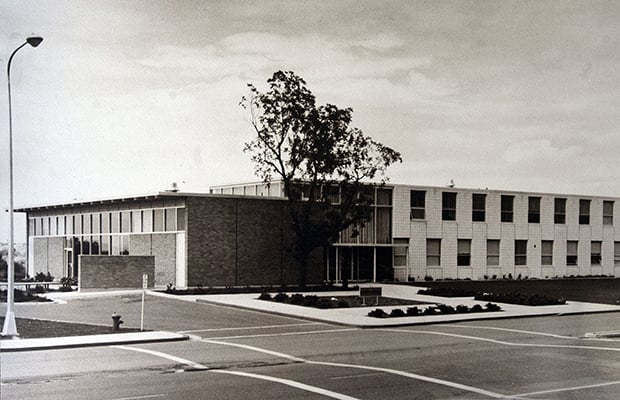
“The Alumni House is where the original Missionary Language Institute began. In November of 1961, university officials and others involved with the ‘pilot program’ assembled here to discuss plans for the new language institute. This building provided classroom and office space for missionary training until June of 1963.” —This is the caption information found on the frame plaque accompanying this photo, one of nearly a dozen historical photos showing the development of the Language Training Mission and Missionary Training Center facilities in Provo since the 1960s. Photo provided by the Provo Missionary Training Center.
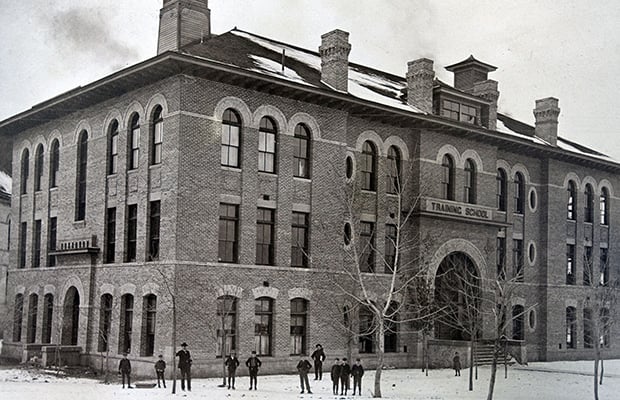
“During the early 1970s, the Men’s Gym was used at times as living quarters for missionaries. The Gym is in the Training Building of the old Brigham Young Academy campus, located between 500 and 600 North on the east side of University Avenue.” —This is the caption information found on the frame plaque accompanying this photo, one of nearly a dozen historical photos showing the development of the Language Training Mission and Missionary Training Center facilities in Provo since the 1960s. Photo provided by the Provo Missionary Training Center.

“The Amanda Knight Hall, a Brigham Young University dormitory, was assigned to the Language Training Mission in July of 1964. It served as a residence hall and classroom primarily for German-speaking missionaries until August 1976.” —This is the caption information found on the frame plaque accompanying this photo, one of nearly a dozen historical photos showing the development of the Language Training Mission and Missionary Training Center facilities in Provo since the 1960s. Photo provided by the Provo Missionary Training Center.
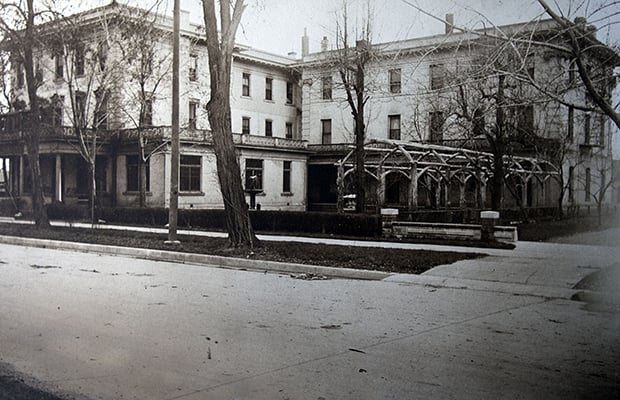
“The Roberts Hotel in downtown Provo was the first residence hall for missionaries. Because the decision to create the Missionary Language Institute evolved rather quickly in 1961, there was not enough time to obtain the already occupied campus housing. After six months, housing was located nearer the campus, although missionaries stayed in the hotel off and on during the 1960s when other rooms were unavailable. At times, missionaries occupied the entire top floor.” —This is the caption information found on the frame plaque accompanying this photo, one of nearly a dozen historical photos showing the development of the Language Training Mission and Missionary Training Center facilities in Provo since the 1960s. Photo provided by the Provo Missionary Training Center.
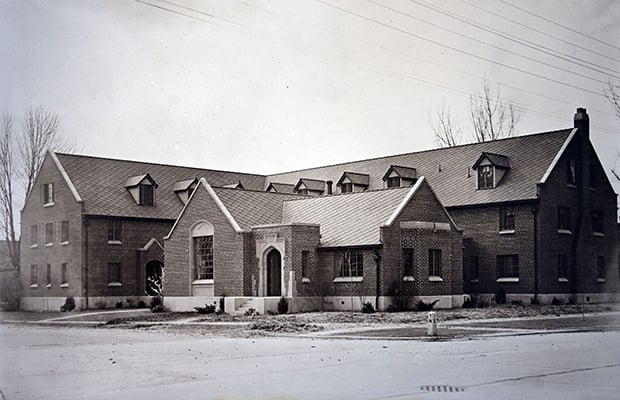
“The Allen Hall served as another residence for missionaries. It was acquired by the Institute in June of 1962 because it was close to campus and had its own cafeteria. Mainly, Portuguese-speaking missionaries lived in Allen Hall until 1976.” —This is the caption information found on the frame plaque accompanying this photo, one of nearly a dozen historical photos showing the development of the Language Training Mission and Missionary Training Center facilities in Provo since the 1960s. Photo provided by the Provo Missionary Training Center.

“At times during the early 1970s, missionaries were asked to live in some unlikely places—the Women’s Gym was one of them. The Gym is located directly across the street from the old Brigham Young Academy on University Avenue in Provo.” —This is the caption information found on the frame plaque accompanying this photo, one of nearly a dozen historical photos showing the development of the Language Training Mission and Missionary Training Center facilities in Provo since the 1960s. Photo provided by the Provo Missionary Training Center.
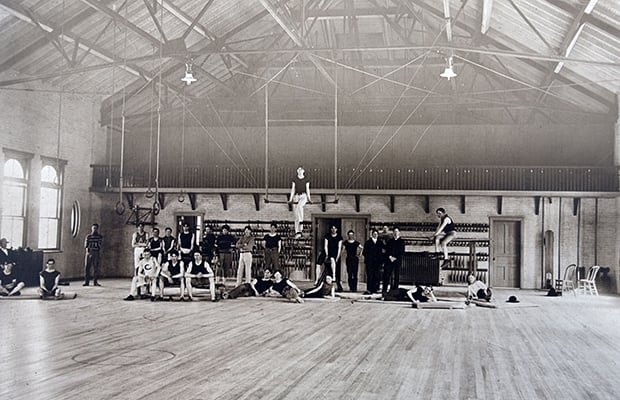
“When the Language Training Mission was faced with overcrowded conditions, missionaries were required to live in the Men’s Gym. Elders who stayed in the gym called it the ‘Provo Hilton.’” —This is the caption information found on the frame plaque accompanying this photo, one of nearly a dozen historical photos showing the development of the Language Training Mission and Missionary Training Center facilities in Provo since the 1960s. Photo provided by the Provo Missionary Training Center.
